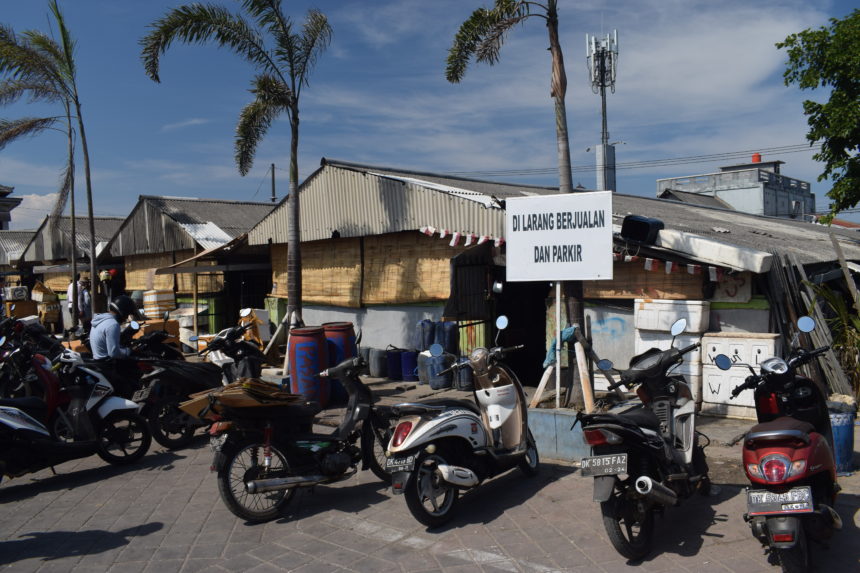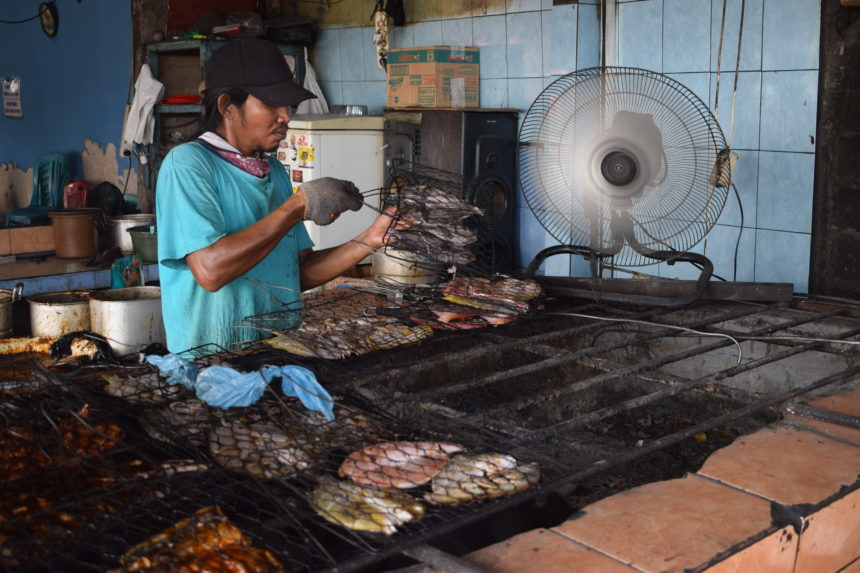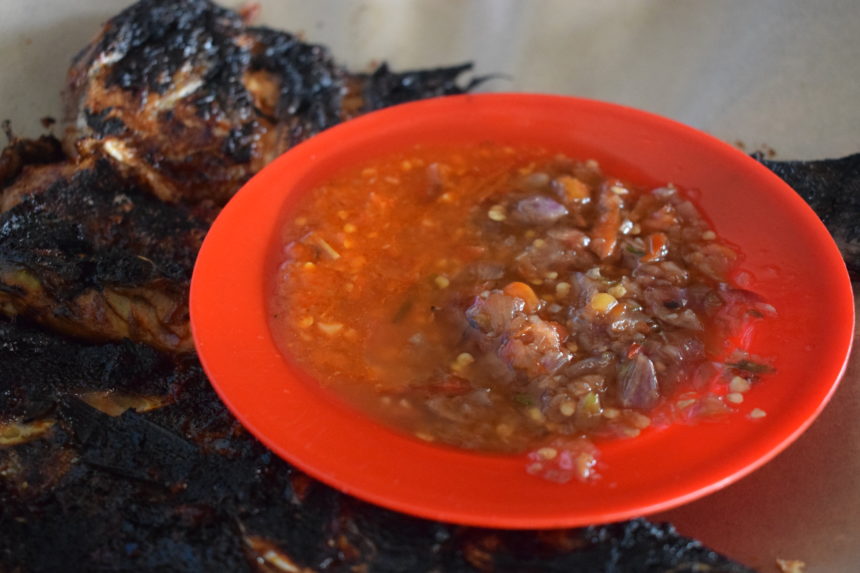
What if I told you that for your next lunch you could go to a market where:
- fish literally has to move 20m across land, from sea to stall;
- you could choose from a huge array of snapper, barracuda, prawn, napoleon fish, oysters, clams, lobsters and more;
- you could then have this cooked 50m away on a giant grill, slathered with local seafood sauce and served with sambals;
- all for less than the price of going out for a burger in London?
You would bite my arm off, wouldn’t you?
Jimbaran fish market (known locally as Kedonganan fish market) delivers all this – and all within view of Denpasar Airport, the gateway to Bali for most.
Sit back and enjoy the photos as I take you on an Indonesian schooling on how to bbq fresh seafood.

Jimbaran, Kuta, Legian – the whole area around the airport is not even my favourite place in Bali, let alone the rest of South East Asia. Packed with tourists on packages, built up, taxi driver cartels – you get the picture. Worst of all for me is the row of identical overpriced seafood restaurants whose tables line Jimbaran beach. 90% of the customers seem to come directly from coaches carrying tourists on package tours in order to enjoy the Instagram-friendly ‘Jimbaran sunset dinner’.
Although the sunsets are indeed impressive, any hungry traveller who values their food (and their wallet) will have better luck heading to other areas of the island.
This statement would be true if it were not for the seafood heaven that is Jimbaran fish market. Just a little further along the seafront road from the aforementioned overpriced restaurants, up by the pier where all the fishing boats come in, lies a squat tented market bustling with locals – a needle of culinary quality hidden amongst a haystack of mediocrity.

Prepare for sensory overload
Not only is Jimbaran Fish Market hidden in a geographical sense; even the entrances themselves are unassuming. Duck your head and make your way through one of these openings and, like the wardrobe door to Narnia, you enter a magical world.

Unlike Narnia, this world is a sensory overload. Depending on your luck, the smell can range anywhere from the sweet smell of fresh shellfish, to the less appealing stench of gut buckets. The sight however, is unarguably beautiful. Tables covered with fish and shellfish of all imaginable sizes, shapes and colours stretch to the dark depths of the market.

At times like these, it is best to let the photos to do the talking:
3 Steps: how to bag the seafood lunch of your dreams at Jimbaran Fish Market
Visiting Jimbaran Fish Market is fairly straightforward, and I would encourage anyone in the area to pay it a visit. However, I have put together a step-by-step guide to the process of buying and cooking the fish to take the uncertainty out for any new visitors. Just follow the steps below and you will be dining on lobster in no time!
Step 1 – choose your fish
This is the fun part! There probably won’t be many times in your life where you are able to choose anything from such a wide selection of seafood without giving yourself a financial headache (aside from the 10-kilo lobsters perhaps). I felt like an excited child at their first buffet experience. So enjoy it for what it is and see it as an opportunity to try something you might have always wanted to.
Having been a couple of times, my personal opinion is that white fish of any sort were the best value and tastiest, especially if you bought a larger one. You get a lot more meat for your money and they become harder to overcook on the interior, so you end up with crispy skin and soft white flesh. Having said that, everything we bought and ate was delicious.
Although Jimbaran is a local fish market, one of the best things about it is that a lot of the stresses that can come with market experiences are not there.
Firstly there isn’t much haggling to be done. There are so many stalls with similar wares that you just wander around asking for prices and you will very soon get a feel for the market rate. To give you an idea, some of the prices we paid are below:
- Lobster = 300k IDR/KG for a small or 350k for a large one
- Calamari = 75 IDR/kg
- Red snapper = 70-80k IDR/kg (a large fish that will feed 2 hungry people is 100k IDR, or £5.50).
- White snapper = 40k IDR/kg
- Prawns = varied a lot depending on size and type (the darker ones had a lot more flavour, but were more expensive). Around 110-180k IDR/kg
- Razor clams = 80k IDR/kg
- Scallops = 80k IDR/kg
Second, in a market where the catch literally comes straight off the boat, freshness isn’t a huge worry – all of the fish I had a look at were fine. Having said this, it is still a very good idea to check before you buy. Below are the 4 things to look for in fish:
- the gills should be pink, not grey. Don’t be afraid to get in there with your fingers and lift the gill arches up to have a look
- they eyes should be clear and convex – not cloudy or sunken
- the flesh should be firm, and have some bounce back when you press your finger into it
- very fresh fish do not smell ‘fishy’. A slight fishy twang is common, but anything that smells particularly strong might be off

Finally, if you have bought a fish, you can tell the vendor that you will be taking it to the warungs next door. He will be able to descale and gut it for you. If you forget don’t worry, they can also do this at the warungs themselves.

Step 2 – cook your fish
As a tourist, the very best bit about Jimbaran Fish Market is that you don’t even need access to a kitchen to get in on a slice of great value fresh seafood. Often, I wander round foreign markets with a lot of intrigue but also a tinge of sadness that I cannot actually cook and eat the ingredients on show. Not at Jimbaran however.
The warungs, a mere stone’s throw away from the market itself, will cook any seafood you buy for 20k IDR per kg (i.e. not much).

There are 4 warungs next to the seafood market which you cannot miss (just head left once you come out of the sea-facing entrances and you will see them). Having visited 2 myself (see images below), I can say you don’t really need to worry about which one to choose. All will cook your seafood on a large charcoal bbq for the same price. In any case, you have already done most of the hard selection work by taking the time to choose your own seafood.
The only slight difference between them is the sambals they choose to serve (details below, for the sambal enthusiasts for whom this will make a difference).
Just pick one, hand over your bags of seafood and watch in awe as they are grilled before your eyes.
Step 3 – eat your fish
No talking required, and prepare to get your hands stuck in.

Sampling the famous Jimbaran seafood – what we ate
We visited a couple of the Warungs: Warung Jegeg and Bakar Ikan Made Ripuk. As I have already alluded to, there’s not much to split them besides the sambals. Both meals consisted of your grilled seafood of choice basted in sauce, rice, and finally the selection of sambal. Other dishes such as steamed veg, were also available. The below gives a summary of everything we tried.
How to cut and grill fish Jimabaran-style
The guys on the grill were clearly not afraid to take on anything from the market. Whole barracuda, clams as big as your fist, scallops, crab, even whole lobster – nothing was too big or too awkward.

All were cooked in a similar fashion.
First came the preparation, which varied depending on the seafood in question. Clams were opened, lobsters sliced in half lengthways, long fish simply cut in half so that they could fit in the grill basket.

All fish were all prepared in the classic ‘Jimbaran-style’. This involved butterflying the fish by cutting it in half lengthways from the dorsal side downwards until there was only the ventral skin of the fish holding the two halves together. The two halves could then be splayed out. This allowed both sides to cook quickly so that the skin did not burn too much. It also allowed for double the amount of sauce it could hold (never a bad thing).

After prep, everything was placed in a grill basket and barbecued directly over the white-hot charcoals. This first grilling stage was naked, without seasoning of any sort.

Seasoning was provided later, about 2/3rds of the way through cooking, when they were taken off the bbq and slathered (literally, with a paintbrush) in the warung’s own seafood sauce, before going back to the grill to finish cooking.
How it tasted
In a word – delicious.

Everything had the same sweet, salty and smoky taste that came from both the grilling over charcoal plus the sauce.
Secret seafood sauce
This sauce was dark in colour and acted almost as an all-in-one seasoning – paint it on two-thirds of the way through cooking and no need to worry about any salt or other flavourings.
It was sweet and salty, and slightly fishy with a very mild kick of chilli – a bit like a sambal terasi but with less chilli and no tomato. It was also noticeably oniony, as if it contained caramelized onions. When the sauce itself began to thicken and glaze the seafood after cooking, the sweet, salty and oniony flavours were enhanced.

The seafood
Underlying the sweet/salty/smoky flavour were the subtler differences in the flavours of the seafood itself. All were delicious, however some lent themselves more readily to the method of cooking being used.
The best were the large fish which, as mentioned before, were big enough to avoid the interior meat becoming overcooked. The combination of this soft juicy flesh plus the crispy sauce-covered skin was delicious. For me, the red snapper and barracuda were the pick of the bunch.

The larger clams too were particularly soft, and the sauce seemed to thicken and caramelize on their shells in a delicious way.

On the other end of the scale, the grill unfortunately did not bring out the best of the lobster. Although still great, in my opinion one of the best things about lobster (as opposed to prawns) is the softness of the meat, and the harsh flame of the grill directly applied to the flesh was enough to harden and dry the meat to an extent.

The sambals
Finally, could a review of an Indonesian meal be complete without a breakdown of the sambals? These are listed in preference order, favourite first.
Sambal terasi – This was my favourite as it was light and paired with the seafood very well. This was a classic fresh sambal terasi (rather than the goreng kind), and so was characteristically light. The lightness was then enhanced with extra lime juice, which went very well with all of the seafood
Sambal matah– The classic, and good as ever. This was a little more oily and heavy on the lemongrass than most.

Garlic paste – I don’t think this can be counted as a sambal because of the lack of chilli, but it was amazing. It was essentially a garlic butter (but more like garlic with a hint of butter as opposed to the other way around). It was most probably lots (and lots) of roasted garlic blended with a little butter to make a sauce consistency.

Summary
Jimbaran Fish Market is a world away from the fairly sterile tourist-oriented offerings in the surrounding area. The market itself will leave you with fishy hands from your fish inspections, and a dripping back from the man who squeezed past you with a box containing 20 red snapper. The Warungs are also full-on – we left with streaming eyes from the smoky grill and streaming noses from the fiery sambals.
All of this however only adds to the theatre of it all. You will struggle to find anywhere near Denpasar where you will get such a full-on and exciting food experience. More importantly though, you will struggle to find anywhere full stop that will allow you to get such an incredible and inexpensive seafood feast. Even better, it is remarkably easy for any tourist to wander in, have a good look around, and come away with their own personal feast.
If you are in the Denpasar area, skip the sea-front row of Jimbaran seafood restaurants that plaster Instagram. Instead come straight to the market – your adventure will be rewarded with the best seafood in Jimbaran.

Price and Location
Prices
Prices are cheap, especially by Western standards. I have given a full breakdown of prices/kg for different seafoods in the article (see ‘Step 1 – choose your fish’).
To give you an idea of what this translates to, a large red snapper (1.2kg, enough to feed 2 very hungry people) will cost 100k IDR to buy and 24k IDR to cook. Served with white rice and sambals, the whole meal will come to 134kIDR (=£7.42 = $9.56).
Red snapper is a more premium fish (but I think worth paying extra for vs, say, white snapper). Other just as delicious fishes, such as mahi-mahi and barracuda are about half the price of the red snapper.
What time does Jimbaran Fish Market open?
Open Everyday. Official time: 4AM-9PM*
*Google suggests that the market is open until 9pm. However, I spoke to one of the vendors and they packed up at 6. I would therefore advise that the best time to visit Jimbaran fish market is for lunch or an early dinner. The Warungs open at 11am, in time for lunch and appear to close late.
If you have your own kitchen and just want seafood to cook yourself, then anytime before 6 (although go first thing if you are determined to get first dibs on the catch).
How to find the market and warungs
Jimbaran Fish Market (= Jimbaran Seafood Market = Kedonganan Fish Market)
Address: Jl. Pantai Kedonganan, Kedonganan, Kuta, Kabupaten Badung, Bali
The warungs are literally 20 metres from the market. Just come out of one of the market entrances facing the sea and turn left. Bakan Ikan Made Ripuk will be on your left, Warung Jegeg and 2 similar warungs will be straight ahead. Just follow the smoke and smell of barbecued seafood!
Warung Jegeg
Address: Jl. Pantai Kedonganan No.1100, Kedonganan, Kuta, Kabupaten Badung, Bali 80361
Open From: 11AM-9PM
Bakar Ikan Made Ripuk
Address: Kedonganan, Kuta, Badung Regency, Bali
Open From: 7AM-8PM











